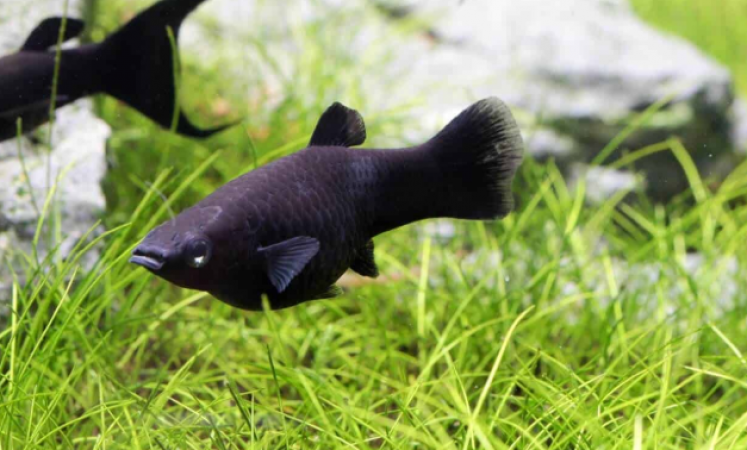Ultimate Guide To Molly Fish Care, Breeding, Tank setup and More
- Jun 19, 2020
- mujtaba ahmad
- 4897 0 0

In fishes, Molly Fish is the top trending commonly known fish nowadays. They are popular due to their beautiful color variations, peaceful nature, calm temperament, and a lot of varieties and species. 'Mollies,' also known by the name Mollienesia in Latin, is a small-sized tropical fish which was originated from the coastal waters of South and Central America. It belongs to the Poeciliidae family.
Why Mollies adopted by beginners? Because of the reasons below, everyone wants to choose them for their tank.
- Their ability to live in both the fresh and salt waters
- Peaceful Nature
- Cool temperament
- And colorful body
Are coupled together to make them one the most popular fish species among all the fish-keeping community worldwide. All Fishkeeping lovers love mollies.
Types of Mollies:
Mollies have some of the most attractive yet rare varieties of formerly classified live-bearer fishes that are available nowadays. The Sailfin Molly, for example, is considered to be the most interesting, beautiful, and attractive fish out of all the species available.
Grouping of Mollies by Colors:
Depending on certain factors, they can be grouped as follows:
- Silver - they have a look of white.
- Gold - has a yellow-orange color combination.
- Black - purely has a black shade.
- Red - orange color and at times have gorgeous pink eyes.
- Dalmatian - has a white body with black spots on it.
- Marble - has black, orange, and yellow spots on it.
- Platinum - a beautiful silver color that glows when taken in black light.
- Green - with some unique green tone.
Feeding Your Fish:
They are omnivores in the wildlife, so their food is based on invertebrates, algae, and plants. But these food materials are hard to provide at-home aquariums naturally.
But instead, you can use artificial stuff, or they might also be fed on vegetables, flake food and a lot of variety of fish foods available in shops nowadays. Mollies mostly like to have green foods like peas, cucumber, spinach, and zucchini. You can also feed them frozen food like bloodworms, brine shrimp, bloodworms, and glass worms, which are essential for breeding.
A list of food items for mollies:
- Flake food
- Algae
- Aquatic Plants
- Glass worms
- Bloodworms
- Blackworms
- Brine Shrimps
- Fry Mollies
- Insects Larvae
- Spinach
- Daphnia
- Zucchini
- Lettuce
- Peas
- Cucumber
- Protein Pallets
- Meaty Food
How often to feed?
Mollies are very active fishes, so they need more food. You should feed mollies every day without skipping a single day.
How much to feed?
The amount of food might vary among different inhabitants. Just notice if the food is left at the bottom of the tank, then decrease that quantity from their food, and you will get the exact amount of food for your mollies.
Is it okay to buy fish food available in the market?
Yes, it is okay to feed your mollies the food products available in markets but must use the high-quality food items. Good quality market fish food has all the necessary proteins required for the better growth of molly fish. So, it is safe to use them.
Tank Setup:
Mollies need Enough space for Swimming because they are live-bearing fishes, so they need a Good tank with a heating system, lighting filter, and air pump for them. I have compiled a detailed article on tank setup and small tank Vs. Bowl for them.
Molly Fish Breeding
Mollies become reproductive at a very young age, and they don't need special conditions for breeding. Instead, the most suitable environment for them to breed is a clean tank and warm water. I will recommend not changing the water as a whole instead change a portion of it in a week so they can't get disturbed by the changes. They can breed very easily, and female mollies are pregnant almost all the time. Place some long-leafed plants because the pregnant mollies need some darker and peaceful corner in the tank.
Mating Behaviour:
One male molly fish can mate with multiple female fishes, so it's better to keep one male molly with 3 to 4 female mollies. Male molly usually shows the chasing behavior for mating while female also signals positively if they wanted to mate; otherwise, the male continues to chase. Male goes under the female to mate and uses their gonopodium (anal fin) to fertilize female molly by ejaculation.
What type of fertilization Mollies undergo?
Mollies and all the other live-bearer fishes undergo internal fertilization. This means the eggs fertilize within the female molly and give birth to fry fishes, which are the smaller/tiny duplicates or copies of adult mollies.
Signs of Pregnancy
Mollies often show some prominent behavioral traits as well as their physical appearances, which indicate that they are pregnant. Pregnant mollies search for the darker and peaceful corner in the tank and sometimes get detached from their tank mates. A black line on the lower side of the belly also represents their pregnancy. While after a few days, a clear swallowed belly is enough to notice the pregnancy.
How much time mollies take to give birth?
After 3 to 6 weeks of pregnancy, mollies give birth to their babies. So mollies usually don't have a long pregnancy period. As they give birth to fry fishes, so they don't have parenting habits, even they can eat their babies.
The number of babies born:
Mollies can give birth to approximately 10 to 40 babies at a time. While sometimes they can also give birth to a hundred of mollies, but it's not necessary that all the fry fishes can survive longer, especially when kept with other adult mollies.
How to care for fry mollies?
Molly fish don't have parenting habits, so fry mollies have to survive on their own. Parent mollies can even eat their babies, and hence a few fry fishes can survive until adulthood. If you need all your fry mollies to survive, then you should either put them in a separate tank or by providing them space to hide like long-leafed plants.
Fry Molly Food:
Fry mollies can easily feed on the food you feed to adult mollies. But if you are proving larger sized chunks, then it's better to grind the food for fry fishes to feed comfortably. For faster and better growth, feed them meaty food like bloodworms, brine shrimps, glass worms, and blackworms to attain the best color variations and shapes for them.
Molly Fish Tank Mates
It's not easy to choose the best tank mates as every fish has different habits, aggression levels, temperaments, swimming habits, food likeability, and many other factors. So, you must choose the tank mates very wisely, and after great knowledge of every inhabitant, you are keeping.
Can Mollies stress out easily?
Mollies are usually known for their calm temperament and peaceful nature, while that doesn't mean that they will never face any issues with their mood. Yes, mollies can stress out but some strict circumstances.
If they are known for their peaceful temperament, then they also need other fishes with them to be the same friendly nature. If you keep them with the highly aggressive fishes, then they might get bullied by them every time and stress out easily.
There are a lot more factors that cause them to depress from the correct selection of food to the tank. Water temperature, lack of oxygen in the water, low-quality food, or less intake of food can easily stress them out. A dirty tank can also be the primary reason for their stress as harmful chemicals and proteins might affect their health.
Mollies also enjoy a lot of plants in their tanks, especially the pregnant and fry mollies. If they won't get enough darker corners and space to hide, they will stress out and might die if this situation continues to disturb them.
Are Mollies aggressive or kill fish?
Mollies can be aggressive and might even kill other fishes but not every time. No fish is interested in killing and showing aggression to other tank mates unless and until they are disturbed. As the nature of males in every living being, male mollies are usually more aggressive than females.
A lot of males together are even more aggressive and killers. So, never keep too many males in the same tank. Males usually have a bossy nature and how a lot of bosses can survive in the same place. It is better to let one male rule over 5 to 6 females. They will be happy with that.
Talking about female molly fish, they are not aggressive at all and so killing is far apart for them. As you know, mollies breed almost all the time, and females are mostly pregnant, so females often prefer to reside away from other tank mates in darker and peaceful corners of the tank.
How long does a Molly Fish live for?
As you know, mollies have a lot of variety and species, so their survival time also varies from every species. The life span of a molly fish is usually 3 to 5 years, but they can survive even more than this period if they are provided with the best circumstances. The type of mollies living in ideal water temperature, pH level, and proper filtered water conditions can live longer than those living in unpleasant situations.
Mollies living in freshwater can't survive for so long than those living in a little salty or brackish water. Because freshwater causes them certain diseases, and these conditions of continuous illness can take their life.
Some species having smaller size, sluggish nature, or pregnant females need more care and time even for feeding than the others with larger size and active environments.
Are Mollies hard to keep?
Contrary to all the positive perspectives of mollies, they can be the most difficult to keep out of all live-bearers. That might happen due to the unbalanced tank conditions required for them to survive properly. They seem to become sick, sluggish quickly, and might even die in some cases. But I think almost every living being needs a little care and some specific conditions for survival, so there isn't a big deal if your fishes demand some attention.
While most people find it challenging to care for fishes rather than other pets like cats and dogs, and the reality behind this fact is that humans have some things in common with other pets rather than the aquatic pets. So they are harder to keep, but a little knowledge and care can lead your way to handle them easily.'







About author